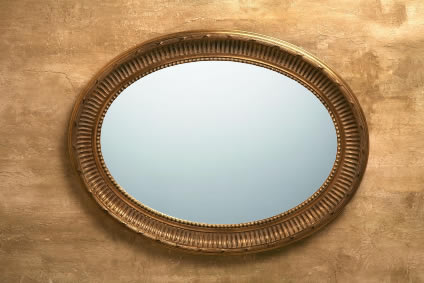Reflecting on the Mirror

Here’s a prediction: in the coming years, we’ll see mirrors popping up in the entryways of churches and other places of worship. And the reason won’t be to let those entering fix their hair. As we’ll see, the mirror has a rather magical effect on us.
For years, motivation experts have told their audiences to “look in the mirror” as they formulated their goals or imagined the future they wanted. As it turns out, this advice wasn’t all motivational hokum. When we look in a mirror, our behavior is actually altered – at least for a short period of time.
Yes! 50 Scientifically Proven Ways to Be Persuasive by Cialdini, Goldstein, and Martin, led me to mirror and related research peformed both by Cialdini and other teams. The most venerable piece of mirror-behavior research is a 1970s study, Social Awareness and Transgression in Children: Two Field Studies, by Beaman et al. Like many experiments in social psychology, the setup was simple: children making their Halloween rounds were told they could take one piece of candy from a large bowl of candy, and then left alone. About 34% helped themselves to more than one piece. When a mirror was placed behind the bowl so that the children could see themselves as they took the candy, only 9% disobeyed their instructions. The simple addition of the mirror cut the rate of bad behavior by almost three-fourths!
And it’s not just kids that respond to seeing themselves. Another experiment described in Yes! showed subjects either a live video of themselves (rather like looking in a mirror except for the image reversal part) or neutral geometric shapes. They were then given a small task which required them to exit the room with a used paper towel. Almost half of the subjects who saw the neutral images “littered” by dropping the used towel in an empty stairwell, while only a quarter of those who saw themselves did so.
It seems that seeing one’s image causes one to think about one’s behavior and ultimately behave in a more socially desirable way. According to Cialdini, other actions can have a similar effect. Asking people their names can have a similar effect, and one experiment showed that a picture of eyes dramatically reduced “theft” in a break area where employees were supposed to drop money in a jar when they were supposed to pay for coffee or tea.
Cialdini notes that mirrors could be an inexpensive way to cut shoplifting or employee theft in areas that can’t readily be monitored.
I think there could well be some interesting marketing applications for this “self awareness” strategy. The most obvious are for non-profit marketers. Generally, they are seeking financial or time commitments for a cause that most people would consider socially beneficial. What better way to boost the success rate than letting potential donors see themselves?
If a solicitation is taking place in an environment controlled by the non-profit, e.g., their office, one or more strategically placed mirrors (in the waiting room, behind the solicitor’s desk, etc.) could work to increase the close rate and perhaps boost the average commitment. Of course, relatively few non-profits have the luxury of bringing donors into their environment.
I think there are applications for this reasearch in the most common way of soliciting contributions, direct mail. The most obvious would be to include an inexpensive reflective area on part of the solicitation, perhaps accompanied by wording that urged the reader to “imagine the good you could do…” While the image quality wouldn’t be as good as a real mirror, the thought would be there. Personalizing the pitch by printing the donor’s name below the reflective area would likely help as well. More costly solicitations aimed at individual large donors could incorporate a real mirror in some way, or perhaps a photo of the donor. It’s even possible that an image of eyes could help, although clearly it would be necessary to incprporate that in a way that made sense and didn’t appear bizarre.
The neuromarketing implications for other sales situations aren’t quite as clear. One application that comes to mind is the marketing of green products. Trying to sell a buyer on an environmentally-friendly hybrid car? Put a mirror in the closing room. Whether this self-awareness phenomenon would apply to self-image factors that aren’t related to desirable social behavior is hard to say. For example, if an individual thought of himself as a rather dashing fellow, would seeing a mirror help sell him a sports car?
At the moment, I think the most probable benefits of using mirrors or other self-images will accrue to marketers who are clearly on the side of what is socially desirable: charities, universities, green marketers, etc.
